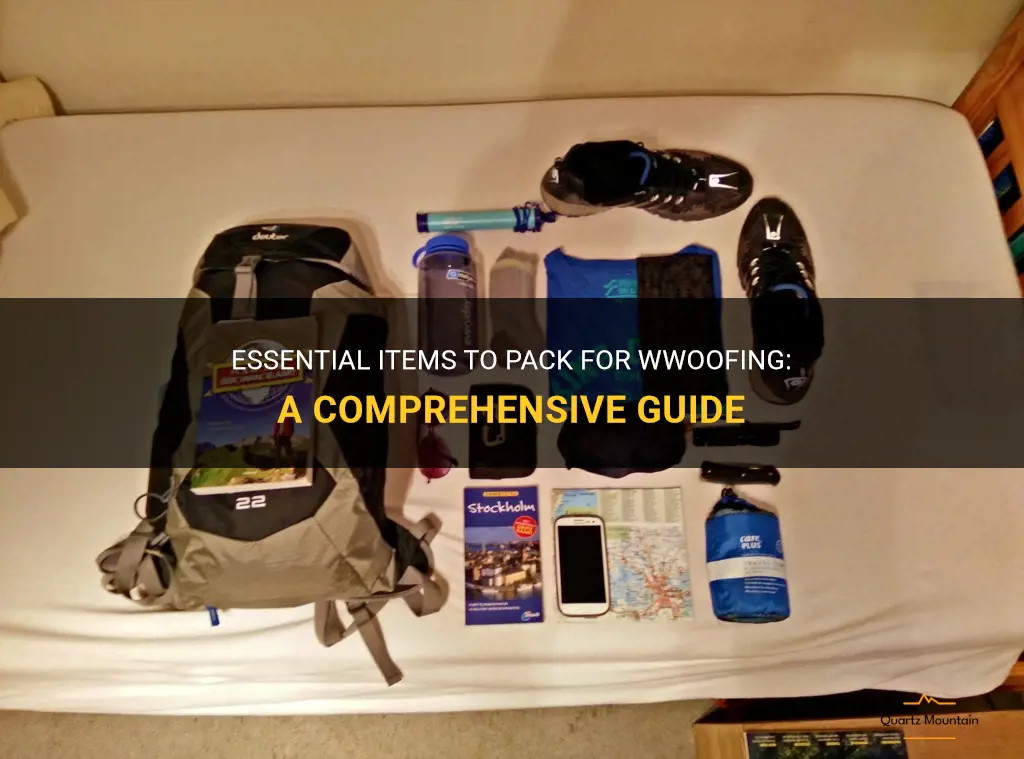
Are you ready to embark on an unforgettable adventure as a WWOOFer? WWOOFing, or World Wide Opportunities on Organic Farms, is a unique opportunity for travelers to immerse themselves in the world of organic farming while exploring new cultures and landscapes. Whether you're planning a short trip or a long-term experience, packing the right essentials is crucial to make the most out of your WWOOFing journey. In this comprehensive guide, we'll delve into the must-have items that should find a place in your backpack before you set off on your WWOOFing adventure. From comfortable clothing and practical tools to eco-friendly toiletries and essential first aid supplies, we'll make sure you're fully prepared to embrace the challenges and rewards that await you on the organic farms of the world. So grab your backpack and let's get packing for a remarkable WWOOFing experience like no other!
What You'll Learn

What essential items should I pack for WWOOFing?

WWOOFing (World Wide Opportunities on Organic Farms) is a popular way for travelers to experience a different culture, learn about sustainable agriculture, and connect with like-minded individuals. Whether you're embarking on a short-term or long-term WWOOFing adventure, it's important to pack the essential items that will make your experience more comfortable and enjoyable. Here are some items you should consider packing for your WWOOFing trip:
Comfortable and durable clothing:
When WWOOFing, you'll likely be spending a lot of time outdoors and engaging in physical activities such as farming, gardening, and animal care. As such, it is crucial to pack comfortable and durable clothing that can withstand the rigors of outdoor work. Opt for lightweight and breathable fabrics that dry quickly and protect you from the sun. Don't forget to pack a hat and a pair of sturdy work boots.
Personal hygiene items:
While WWOOFing, you may not always have access to modern amenities, so it's essential to pack personal hygiene items that will help you maintain cleanliness and good health. Bring travel-sized toiletries such as soap, shampoo, toothpaste, and a toothbrush. Consider bringing a biodegradable soap to minimize your impact on the environment.
Protective gear:
Depending on the type of farm you'll be working on, you may need to pack specific protective gear. If you'll be working with animals, consider packing gloves, sturdy pants, and a long-sleeved shirt to protect yourself from scratches and bites. If you'll be working with machinery or tools, bring safety glasses, earplugs, and a pair of work gloves to protect yourself from potential accidents.
Insect repellent and sunscreen:
When WWOOFing in rural areas, you're likely to encounter insects such as mosquitoes and ticks. To protect yourself from insect bites and the risk of contracting diseases like Lyme disease or West Nile virus, make sure to pack insect repellent. Additionally, don't forget to bring a high SPF sunscreen to protect your skin from the sun's harmful rays.
Water bottle and reusable food containers:
Staying hydrated is crucial, especially when working outdoors. Bring a reusable water bottle that you can easily refill throughout the day. This will help reduce plastic waste and keep you hydrated. Additionally, consider packing a set of reusable food containers as you may be provided with meals on the farm. This will allow you to store any leftovers or pack your own lunch when necessary.
Basic first aid kit:
Accidents can happen anywhere, so it's essential to have a basic first aid kit on hand. Pack items such as band-aids, antiseptic wipes, tweezers, and any necessary prescription medication. Familiarize yourself with basic first aid procedures before your trip to ensure you're prepared for any minor injuries or ailments.
Travel insurance:
Although not a physical item, travel insurance is an important aspect to consider when WWOOFing. It provides coverage for any unexpected medical expenses, trip cancellation, or lost luggage. Make sure to research and choose a travel insurance policy that meets your needs and provides adequate coverage for the duration of your WWOOFing trip.
In conclusion, packing the right items for your WWOOFing trip can make a significant difference in your overall experience. By packing comfortable and durable clothing, personal hygiene items, protective gear, insect repellent, sunscreen, a water bottle, reusable food containers, a basic first aid kit, and travel insurance, you'll be well-prepared for your WWOOFing adventure. Remember to research the specific requirements of the farm you'll be staying at and adjust your packing list accordingly. Happy WWOOFing!
Essential Items to Pack for a Memorable Trip to the Philippines
You may want to see also

How many changes of clothes should I bring for a WWOOFing trip?
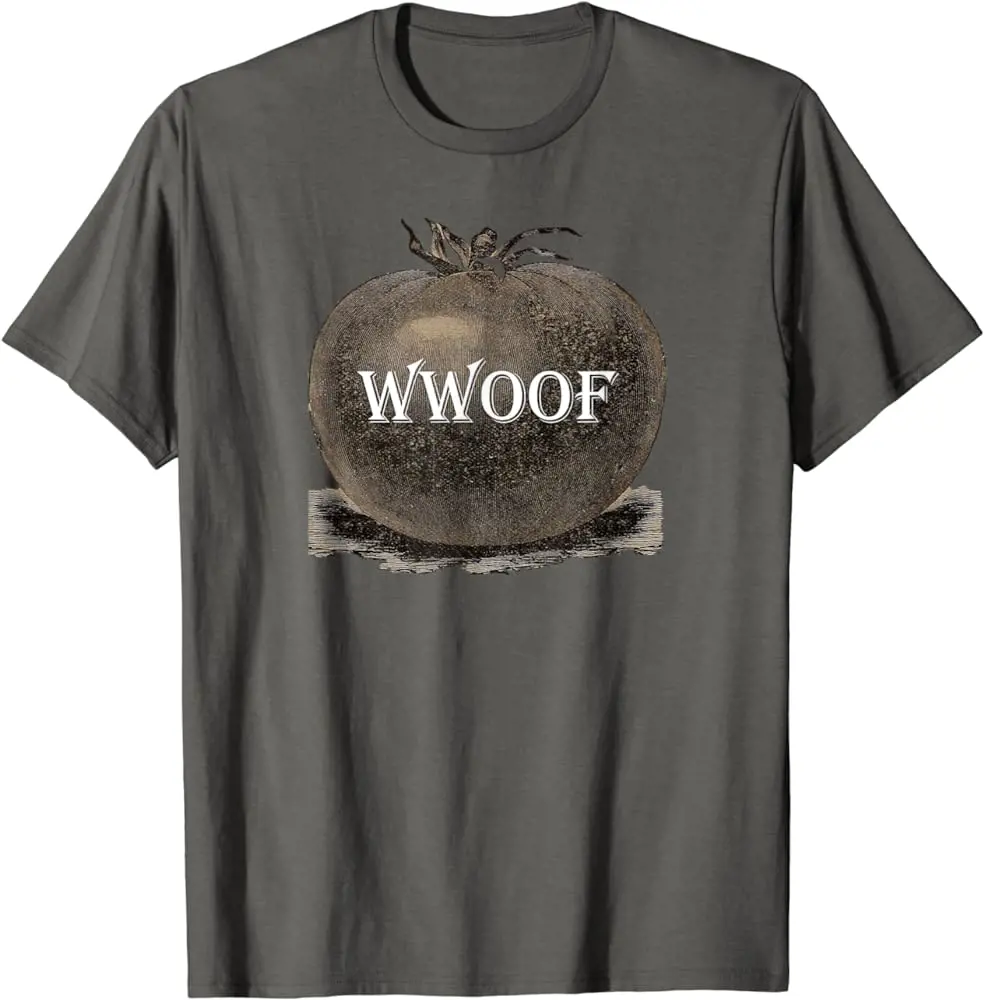
When embarking on a WWOOFing trip, it is important to pack appropriately. One common question that arises is how many changes of clothes one should bring. To answer this question, we need to consider various factors such as the location, duration of the trip, and personal preferences.
- Location: The choice of clothes will depend on the climate and weather conditions of the WWOOFing destination. If you are WWOOFing in a warm and tropical location, lightweight and breathable clothes will be essential. On the other hand, if you are heading to a colder climate, you will need to pack layers and warm clothing.
- Duration: The length of your WWOOFing trip will also determine the number of clothes you should bring. If you are only planning to stay for a week, packing a few sets of clothes should be sufficient. However, if you are staying for several months, you may need a more extensive wardrobe.
- Laundry Facilities: Consider the availability of laundry facilities at your WWOOFing accommodation. If there are no laundry facilities nearby, you will need to bring enough clothes to last until you can find a laundromat or other means of cleaning your clothes.
Based on these factors, a general guideline for the number of changes of clothes to bring on a WWOOFing trip is:
- 1-2 pairs of pants/shorts
- 3-4 t-shirts/tops
- 1-2 long-sleeve shirts for layering
- 1-2 sweatshirts or sweaters for colder climates
- 6-7 pairs of underwear
- 3-4 pairs of socks
- 1-2 sets of sleepwear
- 1-2 sets of swimwear (if applicable)
- 1-2 pairs of comfortable shoes
- 1 pair of sturdy work boots (depending on the type of WWOOFing you will be doing)
- 1 lightweight rain jacket or poncho
- 1 hat or cap for sun protection
It is important to note that this is a general guideline, and your specific needs may vary. You may want to adjust the number of clothes based on personal preferences and the specific requirements of your WWOOFing placement. Additionally, consider factors such as dress code if you are WWOOFing in a formal or religious setting.
Remember, the goal of WWOOFing is to have a meaningful cultural exchange and contribute to sustainable agriculture, so it is important to prioritize comfort and practicality over fashion. Bringing clothes that are versatile, easily washable, and suitable for different weather conditions will ensure a smooth and enjoyable WWOOFing experience.
What to Pack for a 7-Day Cruise to Mexico
You may want to see also

What type of footwear is recommended for WWOOFing?
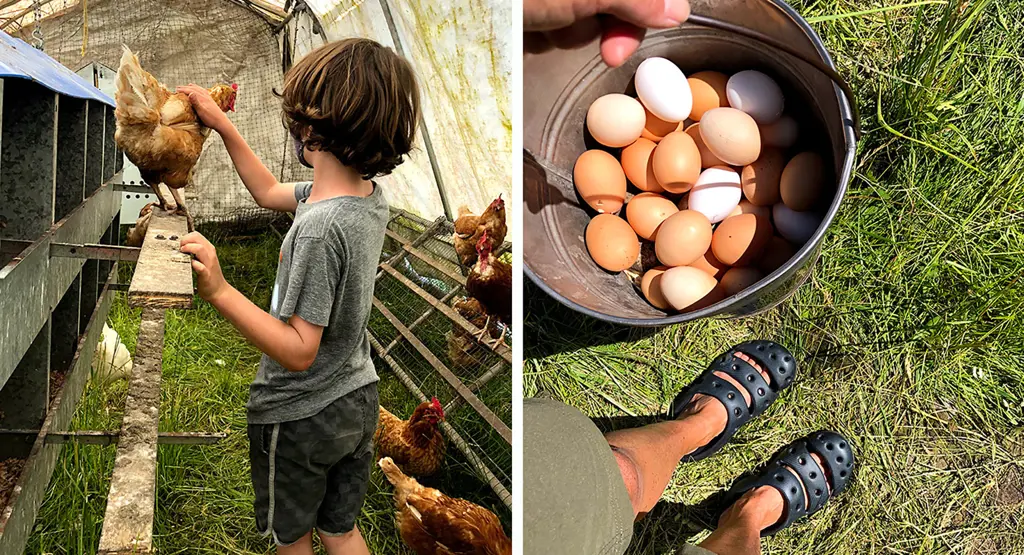
When participating in WWOOFing (World Wide Opportunities on Organic Farms), it is important to wear the right type of footwear to ensure comfort, safety, and productivity during your farming activities. Working on farms can involve various tasks such as planting, harvesting, weeding, and even animal care, so having the appropriate footwear can make a significant difference. Here are some recommendations for the best footwear to wear when WWOOFing.
Sturdy Work Boots:
Investing in a pair of sturdy work boots is essential for WWOOFing. These boots offer protection for your feet and ankles and provide excellent support when walking on uneven terrain. Look for boots made from durable materials such as leather or synthetic leather, with a strong and slip-resistant sole. It is also advisable to choose boots with steel toe caps to protect your feet from any potential hazards.
Hiking Shoes or Boots:
If you are going to be working on a farm with more rugged terrain, consider wearing hiking shoes or boots instead of traditional work boots. Hiking footwear is designed for outdoor activities and provides stability and comfort. They generally have a good grip and traction, making them suitable for navigating through muddy or rocky terrain.
Rubber Boots:
Depending on the season and the type of farm you are WWOOFing on, it may be beneficial to have a pair of rubber boots. Rubber boots are ideal for wet environments, such as working in muddy fields or around livestock. They are usually waterproof and easy to clean, protecting your feet from moisture and potential contaminants.
Lightweight Sneakers or Trail Running Shoes:
If you'll be primarily engaging in tasks that don't involve heavy physical labor or rough terrains, such as gardening or light maintenance work, wearing lightweight sneakers or trail running shoes can be a comfortable option. These types of shoes provide cushioning and flexibility for more prolonged periods of standing or walking, and they are suitable for a variety of tasks.
Sandals or Flip-flops:
While not recommended for all farming activities, sandals or flip-flops can be convenient for quick errands or during breaks. They may not provide the same level of protection as other types of footwear, so it is best to reserve them for times when you don't need to engage in heavy-duty work.
It's important to note that different farms and regions may require specific footwear depending on the climate, terrain, and tasks involved. Before starting your WWOOFing adventure, contact the host farm to inquire about any specific requirements or recommendations for footwear. By wearing the appropriate footwear, you can ensure your safety and comfort, allowing you to make the most out of your WWOOFing experience.
The Essential Packing List for Attending Jennie Finch Softball Camp
You may want to see also

Are there any specific personal care items I should bring for WWOOFing?
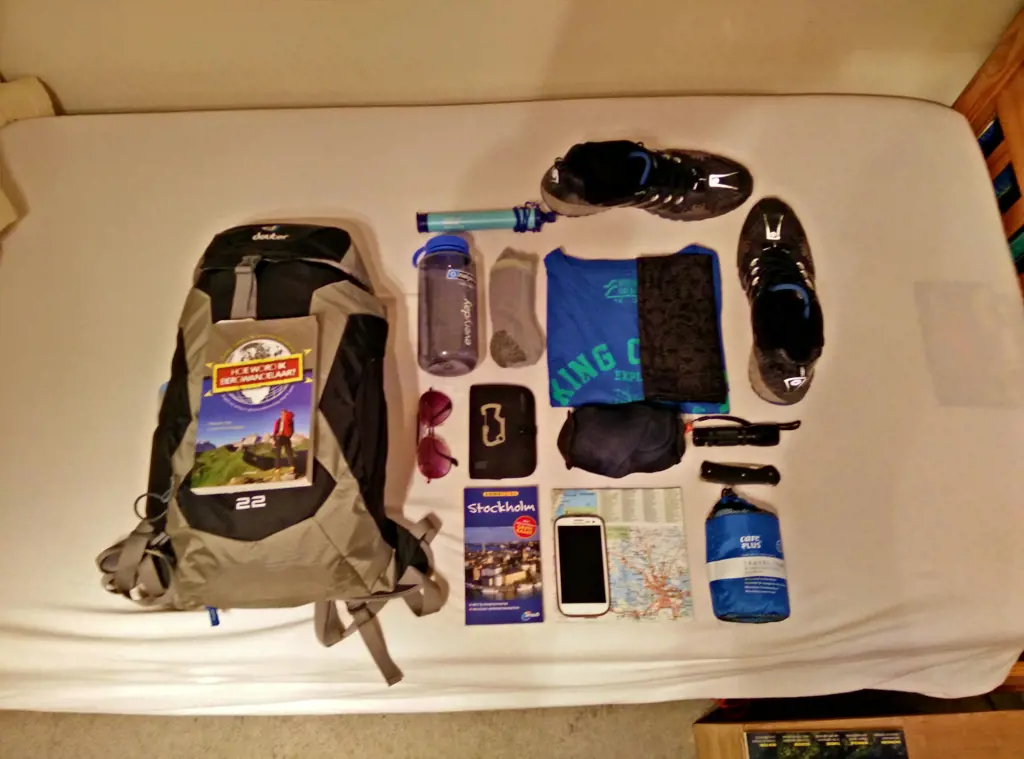
When embarking on a WWOOFing (World Wide Opportunities on Organic Farms) adventure, it is important to consider the personal care items you should bring along. WWOOFing involves volunteering on organic farms around the world, which often means spending extended periods in rural areas without easy access to commercial products. Here are some specific personal care items that can enhance your WWOOFing experience:
- Sunscreen: Spending long hours outdoors can expose your skin to harmful UV rays. Protect yourself by packing a high SPF sunscreen to prevent sunburn and reduce the risk of skin damage. Opt for a water-resistant sunscreen if your WWOOFing activities involve water or sweat.
- Insect repellent: Rural areas often have a higher concentration of mosquitoes and other insects. Protect yourself from bites and potential diseases by packing a reliable insect repellent. Look for formulations that contain DEET or other effective active ingredients.
- Personal hygiene products: While staying on a farm, it's important to maintain good personal hygiene. Pack items such as toothbrush, toothpaste, soap, shampoo, and any other essentials you may need. Opt for environmentally friendly options if possible.
- Hand sanitizer: Farm work can get messy, and access to clean water and soap may be limited. Having a hand sanitizer can help you maintain good hygiene when soap and water are not readily available.
- First aid kit: Accidents can happen, especially when working with tools or farm animals. Ensure you have a basic first aid kit with essentials like bandages, antiseptic wipes, and pain relievers. Familiarize yourself with basic first aid techniques before embarking on your WWOOFing journey.
- Quick-drying towel: A lightweight, quick-drying towel is a practical addition to your personal care kit. It can come in handy for drying off after a swim or showering in areas where traditional towels may not dry easily.
- Comfortable footwear: WWOOFing often involves spending long hours on your feet, navigating uneven terrain. Invest in a pair of comfortable, sturdy footwear that provides adequate support and protection for your feet.
- Clothing suitable for outdoor work: Pack clothes that are appropriate for farm work. Opt for sturdy, breathable fabrics that can withstand rugged conditions and protect you from the elements. Don't forget to pack a hat to protect your face and neck from the sun.
- Prescription medications: If you have any pre-existing medical conditions or take regular medications, ensure you bring an adequate supply for the duration of your WWOOFing experience. It may be challenging to access specific medications in remote areas.
- Reusable water bottle: Staying hydrated is crucial, especially when working outdoors. Bring a reusable water bottle to ensure you have a constant supply of drinking water. Consider a durable, eco-friendly option that can withstand the rigors of farm work.
While this list covers the essential personal care items to bring for WWOOFing, it's important to research and consider any additional items specific to the region and the farm you'll be staying on. Familiarize yourself with the local climate, cultural norms, and any environmental considerations to ensure a smooth and enjoyable WWOOFing experience.
Exploring Italy: Essential Items to Pack for a Month-Long Adventure
You may want to see also

What type of backpack or luggage is best for WWOOFing?
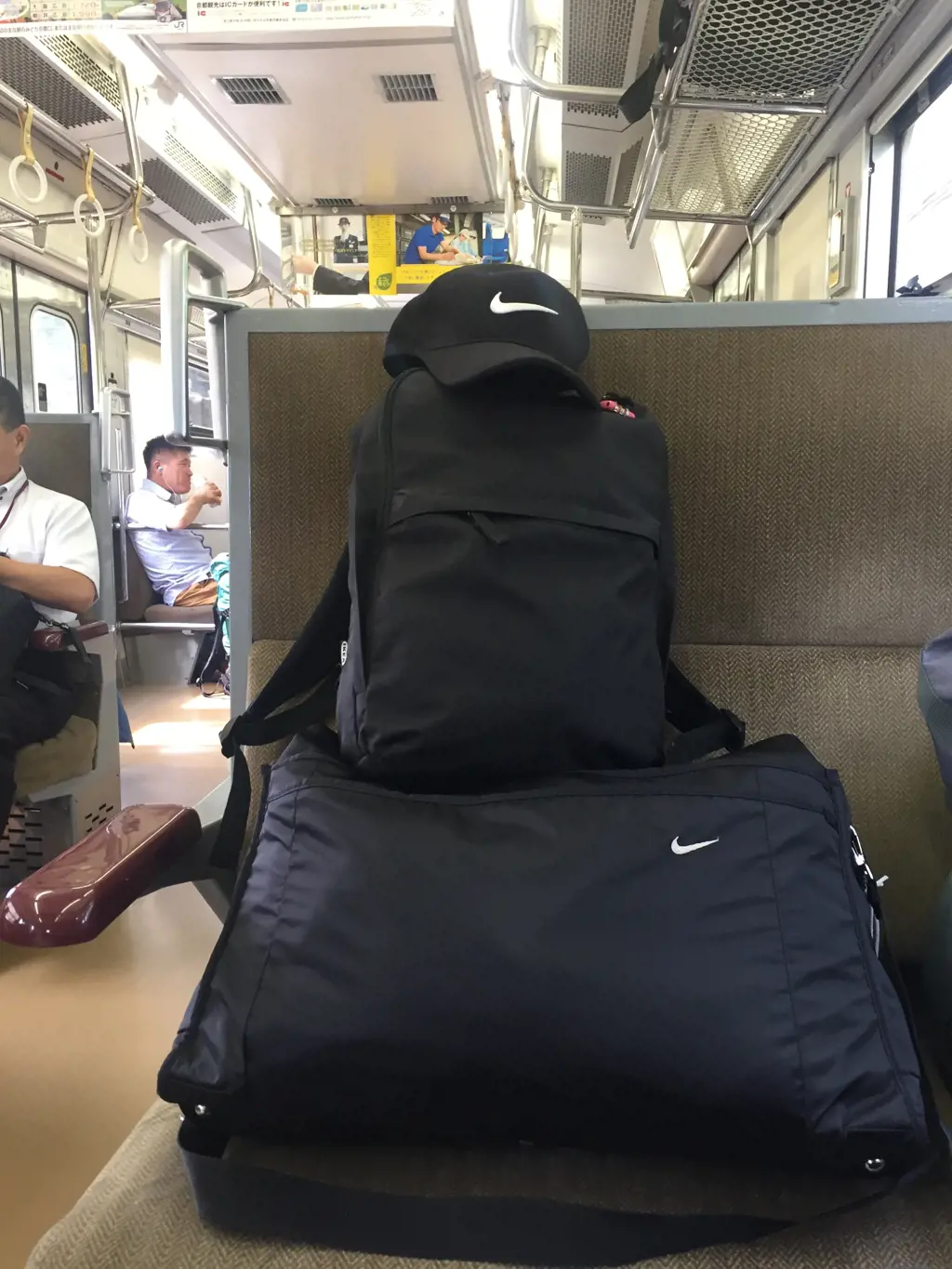
When it comes to WWOOFing (World Wide Opportunities on Organic Farms), having the right backpack or luggage is essential. WWOOFing involves working on organic farms in exchange for food and accommodations, which means you'll be traveling light and staying in various locations. Here's a guide on what type of backpack or luggage is best for WWOOFing.
Size and Capacity:
Look for a backpack or luggage with a capacity of around 40-70 liters. This will allow you to pack all the essentials without being too bulky or weighing you down. Make sure it has enough compartments and pockets to keep things organized.
Durability:
You'll be moving around a lot and possibly working outdoors, so durability is crucial. Look for backpacks made from high-quality materials such as nylon or canvas. Check for reinforced stitching and strong zippers to ensure it can withstand the wear and tear of WWOOFing.
Comfort:
Since you'll be carrying your backpack for long periods, comfort is key. Look for backpacks with padded shoulder straps, a waist belt, and a chest strap. These features distribute the weight evenly and reduce strain on your back. If you prefer a rolling suitcase, ensure it has sturdy wheels and a comfortable handle for easy maneuverability.
Weight:
Opt for a lightweight backpack or luggage to minimize the load on your shoulders and back. Every ounce matters when you're traveling long distances on foot or public transportation. Consider lightweight materials like nylon or polyester, and avoid unnecessary features that add extra weight.
Accessibility:
Choose a backpack or luggage with easy access to your belongings. Look for a backpack with a front-loading or panel-loading design, allowing you to reach items at the bottom without unpacking everything. Similarly, luggage with multiple compartments and external pockets makes it easier to organize and access your essentials.
Water-resistance:
Since you'll be exposed to different weather conditions, having a water-resistant backpack or luggage is important. Look for materials that repel water, or consider purchasing a rain cover to protect your belongings in case of rain or other wet conditions.
Lockable Zippers:
To ensure the safety of your belongings, look for backpacks or luggage with lockable zippers. This will prevent unauthorized access when you're away from your belongings, especially in shared accommodations or public transportation.
Backpack Features:
If you choose a backpack, consider additional features that might be useful during your WWOOFing adventures. These can include a built-in rain cover, a removable day pack for shorter trips, compression straps to secure your load, and a hydration reservoir pocket for easy access to water.
Overall, the best backpack or luggage for WWOOFing is one that is durable, comfortable, and practical. It should have enough capacity to hold all your essentials, while being lightweight and easy to access. Prioritize finding a backpack or luggage that suits your specific needs and preferences, and don't forget to try it out beforehand to ensure a proper fit and comfort.
Delicious and Nutritious: School Lunch Box Ideas for a Healthy Meal
You may want to see also
Frequently asked questions
When packing for wwoofing, it's important to bring practical and comfortable clothing that can be worn in various weather conditions. Think layers that can be added or removed as needed. Additionally, don't forget to pack sturdy and comfortable footwear, as you'll likely be spending a lot of time on your feet. It's also a good idea to bring a reusable water bottle, a hat, sunscreen, and insect repellent to protect yourself while working outdoors.
It's best to pack light when it comes to wwoofing. Depending on the length of your stay, aim to bring a backpack or suitcase that can easily be carried and transported. Avoid overpacking and only bring the essentials. Keep in mind that you may be responsible for carrying your luggage to and from your accommodations, so you'll want to make sure it's manageable.
It's always a good idea to check with the host you'll be staying with before packing bedding and towels. Some hosts may provide these items, while others may require you to bring your own. Contacting the host beforehand will ensure that you come prepared with the appropriate bedding and towels if needed. However, it's always advisable to bring a sleeping bag or sleeping pad in case one is not provided.
If you'll be wwoofing on a farm, there are a few additional items you may want to consider bringing. A pair of work gloves can be helpful for tasks that may require manual labor. You may also want to bring a hat and sunglasses to protect yourself from the sun while working outdoors. Additionally, consider packing a reusable water bottle and a small first aid kit for any minor injuries that may occur while on the farm.







